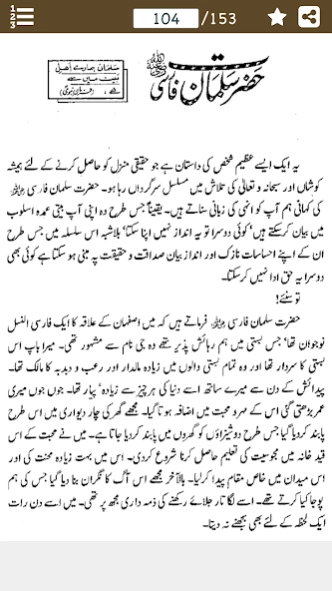Hayat e Sahaba - حیاتِ صحابہ 1.0
Free Version
Publisher Description
Hayat e Sahaba - حیاتِ صحابہ - جلیل القدر صحابہ اکرام کی زندگی پر مشتمل ایک عمدہ مستند اور جامع ایپ
جلیل القدر صحابہ اکرام کی زندگی پر مشتمل ایک عمدہ مستند اور جامع کتب۔ وہ عظیم المرتبت، جلیل القدر ہستیاں ہیں جن کی زندگیاں شمع رسالت سے ضیا بار ہوئیں۔ ان کی پاکیزہ سیرت کا ہر پہلواسوۃ رسول کی کرنوں سے منور ہے۔
Hayatus Sahabah is a masterpiece. A Collection of events and incidents involving the Prophet (may Allah bless him and grant him peace) and his Companions (may Allah be pleased with them all), meticulously categorised by the common lessons and morals these incidents symbolise. This book has been written originally in arabic, later it has been translated in many languages and got popularity among the people belonging to Tablighi Jamat.
Aṣ-ṣaḥābah (Arabic: الصحابة, "The Companions") were the companions of the Islamic prophet Muhammad who had seen or met him, believed in him at the time when he was alive and also died as Muslims. While all the Sahabah were very important in the Islamic faith, there are some which are especially notable and important.
Companions of the Prophet (Arabic: اَلصَّحَابَةُ; aṣ-ṣaḥāba meaning "the companions", from the verb صَحِبَ meaning "accompany", "keep company with", "associate with") were the disciples and followers of Muhammad who "saw or met the prophet during his lifetime, while being a Muslim and were physically in his presence". "Al-ṣaḥāba" is definite plural; the indefinite singular is masculine صَحَابِيٌّ (ṣaḥābiyy), feminine صَحَابِيَّةٌ (ṣaḥābiyyah).
Later scholars accepted their testimony of the words and deeds of Muhammad, the occasions on which the Quran was revealed and other various important matters of Islamic history and practice. The testimony of the companions, as it was passed down through trusted chains of narrators (isnads), was the basis of the developing Islamic tradition. From the traditions (hadith) of the life of Muhammad and his companions are drawn the Muslim way of life (sunnah), the code of conduct (sharia) it requires, and the jurisprudence (fiqh) by which Muslim communities should be regulated.
The two largest Islamic denominations, the Sunni and Shia, take different approaches in weighing the value of the companions' testimonies, have different hadith collections and, as a result, have different views about the ṣaḥābah.
The second generation of Muslims after the ṣaḥāba, born after the death of the Islamic prophet Muhammad, who knew at least one ṣaḥāba, are called Tābi‘ūn (also "the successors"). The third generation of Muslims after the Tābi‘ūn, who knew at least one Tābi‘, are called tābi‘ al-tābi‘īn. The three generations make up the salaf of Islam.
Good book to know the personalities of Sahaba Karam and how Islam brought beautiful changes in to their lives.
A good way to learn about great men of Islam being our role models.
All characters of sahabas are explained in a story form.
In Islām, companions of Muḥammad are classified into categories including the Muhajirūn who accompanied Muhammad from Mecca to Medina, the Ansar who lived in Medina, and the Badriyyūn who fought at the Battle of Badr.
Two important groups among the Companions are the Muhajirūn "migrants", those who had faith in Muhammad when he began to preach in Mecca and who departed with him when he was persecuted there, and the Ansar, the people of Medina who welcomed Muhammad and his companions and stood as their protectors.
Lists of prominent companions usually run to 50 or 60 names, the people most closely associated with Muhammad. However, there were clearly many others who had some contact with Muhammad and their names and biographies were recorded in religious reference texts such as ibn Sa'd's early Book of the Major Classes. Al-Qurtubi's Istīʻāb fī maʻrifat al-Aṣhāb, who died in 1071, consists of 2770 biographies of male and 381 biographies of female ṣaḥābah.
According to an observation in al-Qastallani's Al-Muwahib al-Ladunniyyah, an untold number of persons had already converted to Islam by the time Muhammad died.
About Hayat e Sahaba - حیاتِ صحابہ
Hayat e Sahaba - حیاتِ صحابہ is a free app for Android published in the Teaching & Training Tools list of apps, part of Education.
The company that develops Hayat e Sahaba - حیاتِ صحابہ is Pak Appz. The latest version released by its developer is 1.0.
To install Hayat e Sahaba - حیاتِ صحابہ on your Android device, just click the green Continue To App button above to start the installation process. The app is listed on our website since 2022-02-07 and was downloaded 1 times. We have already checked if the download link is safe, however for your own protection we recommend that you scan the downloaded app with your antivirus. Your antivirus may detect the Hayat e Sahaba - حیاتِ صحابہ as malware as malware if the download link to com.PakApps.HayateSahaba is broken.
How to install Hayat e Sahaba - حیاتِ صحابہ on your Android device:
- Click on the Continue To App button on our website. This will redirect you to Google Play.
- Once the Hayat e Sahaba - حیاتِ صحابہ is shown in the Google Play listing of your Android device, you can start its download and installation. Tap on the Install button located below the search bar and to the right of the app icon.
- A pop-up window with the permissions required by Hayat e Sahaba - حیاتِ صحابہ will be shown. Click on Accept to continue the process.
- Hayat e Sahaba - حیاتِ صحابہ will be downloaded onto your device, displaying a progress. Once the download completes, the installation will start and you'll get a notification after the installation is finished.



